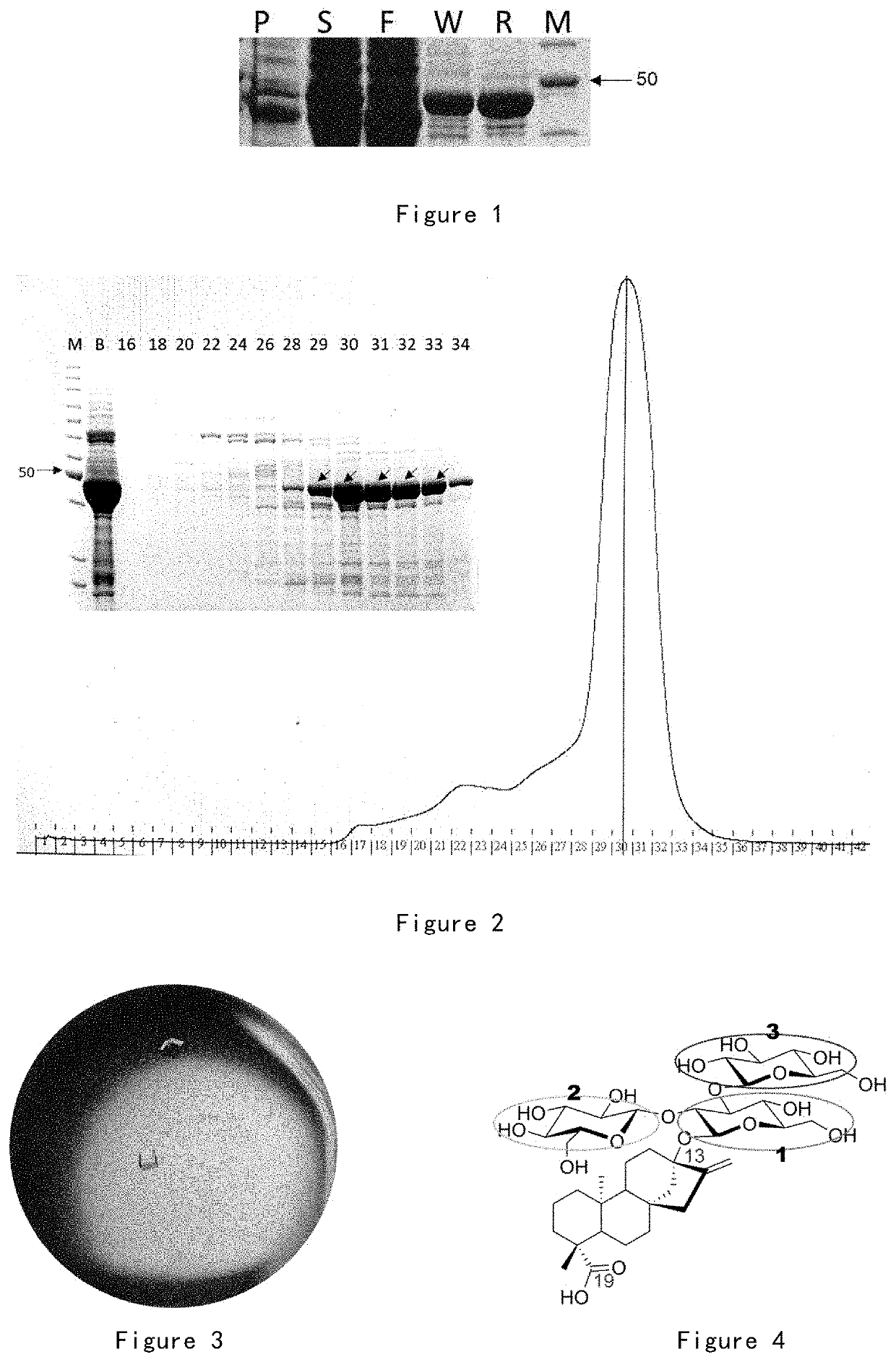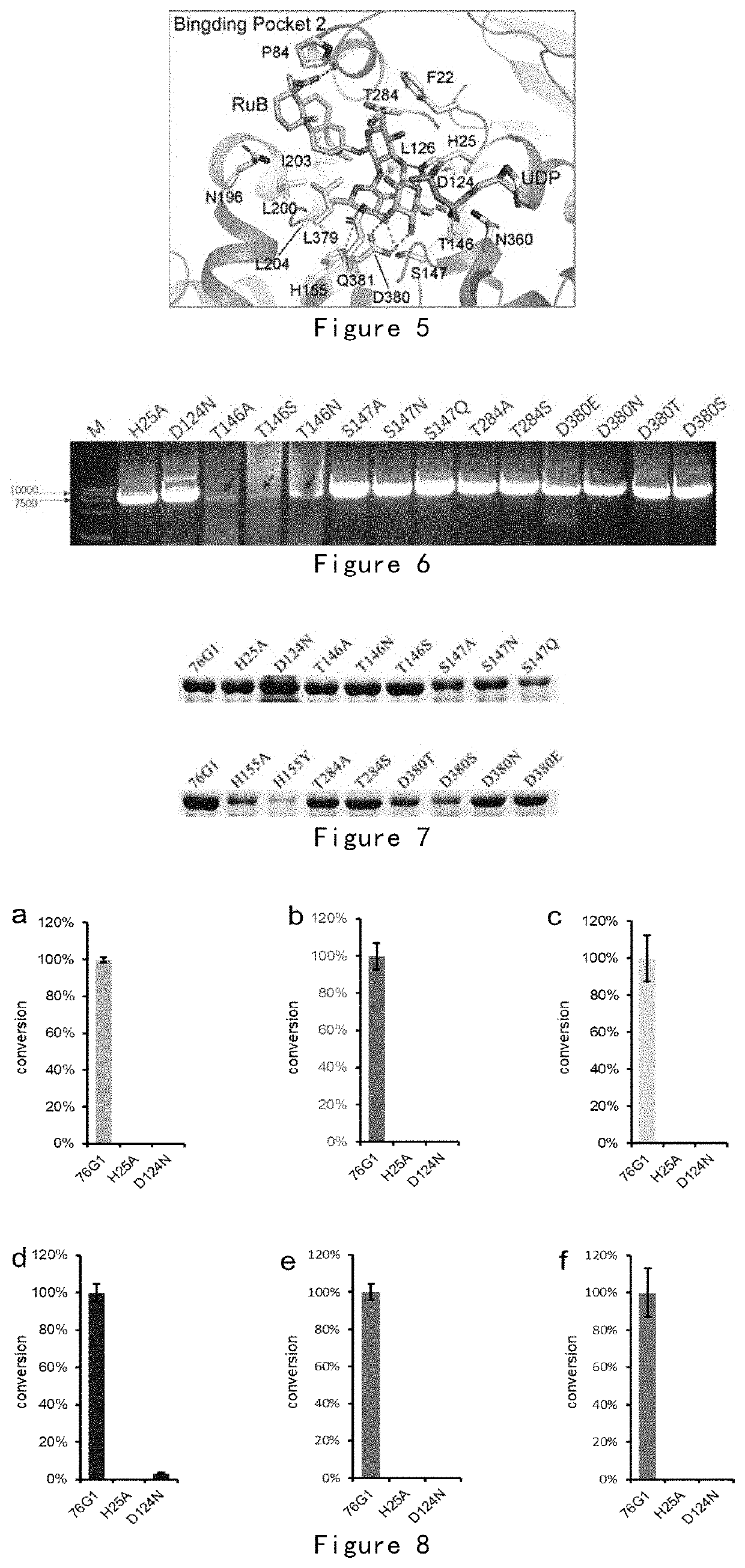Glycosyltransferase Mutant and Use Therefor
- Summary
- Abstract
- Description
- Claims
- Application Information
AI Technical Summary
Benefits of technology
Problems solved by technology
Method used
Image
Examples
example 1
n, Purification, Crystallization and Structure Analysis of UGT76G1 Protein
[0125]1. Construction of Wild-Type UGT76G1 Expression Vector pQZ11
[0126]The target gene was amplified with specific primer pairs (Table 1) and with the codon-optimized UGT76G1 gene cloning vector as the template. The PCR product was cloned into BamHI / HindIII of vector pETDuet1, and the obtained expression vector pQZ11 was verified by sequencing.
TABLE 1Primers used in the construction ofwild-type UGT76G1 expression vectorPrimer NameSequencePrimer_FATTCTGGATCCATGGAAAACAAAAC(SEQ ID NO: 94)Primer_RCGCAAGCTTTTAACTTTACAGAGAA(SEQ ID NO: 95)
[0127]2. Protein Expression and Purification
[0128]E. coli BL21 (DE3) harboring wild-type UGT76G1 expression vector pQZ11 cultured overnight was transferred to 1 L LB at 1% (v / v) and cultured at 37° C. and 200 rpm until OD600≈1.0. The final concentration of 0.1 mM IPTG was used for induction, and the cells were collected after 18 hours of overnight culture at 16° C. Resuspending the...
example 2
ion and Expression of Mutant Protein
[0132]According to the complex structure of UGT76G1-substrate rebaudioside B (FIG. 4) and UDP and based on repeated verifications, the inventor located the substrate binding pocket and identified several key amino acids in the substrate binding pocket (FIG. 5), which interact with glycosyl donor, glycosyl acceptor or aglycon core, respectively. Amino acids were divided into 4 categories according to their functions in the glycosylation process (Table 2). These amino acids were subjected to single-point or multiple-point mutations. Through in vitro enzymatic tests, the mutant proteins were analyzed for catalytic activity and substrate recognition specificity changes in the glycosylation process.
TABLE 2Amino acid mutationAmino acidFunctionMutationH25CatalyzingAD124CatalyzingNT284Stabilization of glycosyl 1A / SS147Stabilization of glycosyl 2A / N / QH155Stabilization of glycosyl 2A / YT146Stabilization of glycosyl 3A / N / SD380Stabilization of glycosyl 3 / E / N / S...
example 3
l Verification of Mutant Protein In Vitro
[0137]1. Enzymic Reaction of Mutant In Vitro
[0138]The enzymic reaction system includes: 10 μg protein, 1.5 mM UDP-glucose, 250 μM glycosyl acceptor substrate buffer (20 mM Tris-HCl, pH=8.0, 100 mM NaCl). The reaction of each mutant protein for the same substrate was repeated three times.
[0139]Reaction conditions: 37° C., 30 min. The reaction was quenched with an equal volume of methanol. After vigorous shaking, the reaction was centrifuged at 12000 rpm for 30 min. The supernatant was used for HPLC detection. Detection method: mobile phase A (acetonitrile)-mobile phase B (water) gradient elution. The peak area of the catalytic product of the mutant was calculated and compared with the peak area of the catalytic product of wild-type UGT76G1.
[0140]2. Catalytic Activity and Substrate Specificity of Mutant
[0141]1) The results of in vitro functional verification are shown inFIG. 8. H25 / D124 directly participates in the deprotonation of glycosylatio...
PUM
| Property | Measurement | Unit |
|---|---|---|
| Length | aaaaa | aaaaa |
| Length | aaaaa | aaaaa |
| Length | aaaaa | aaaaa |
Abstract
Description
Claims
Application Information
 Login to View More
Login to View More - R&D
- Intellectual Property
- Life Sciences
- Materials
- Tech Scout
- Unparalleled Data Quality
- Higher Quality Content
- 60% Fewer Hallucinations
Browse by: Latest US Patents, China's latest patents, Technical Efficacy Thesaurus, Application Domain, Technology Topic, Popular Technical Reports.
© 2025 PatSnap. All rights reserved.Legal|Privacy policy|Modern Slavery Act Transparency Statement|Sitemap|About US| Contact US: help@patsnap.com



